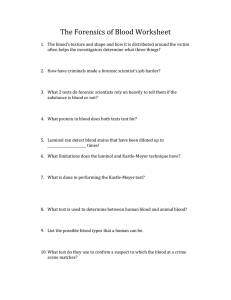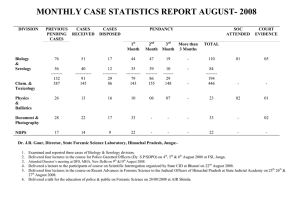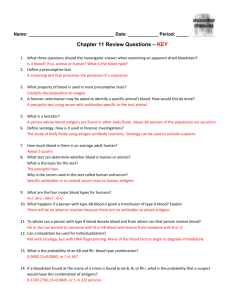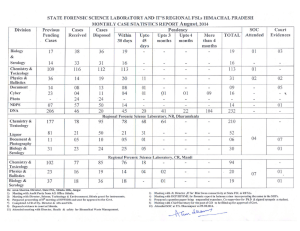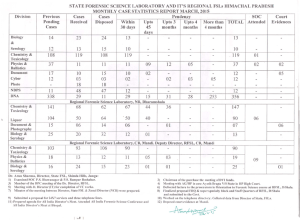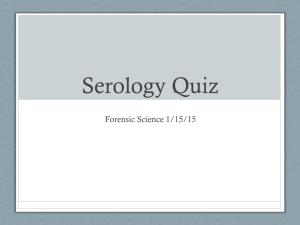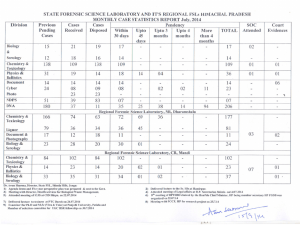Forensic Serology
advertisement
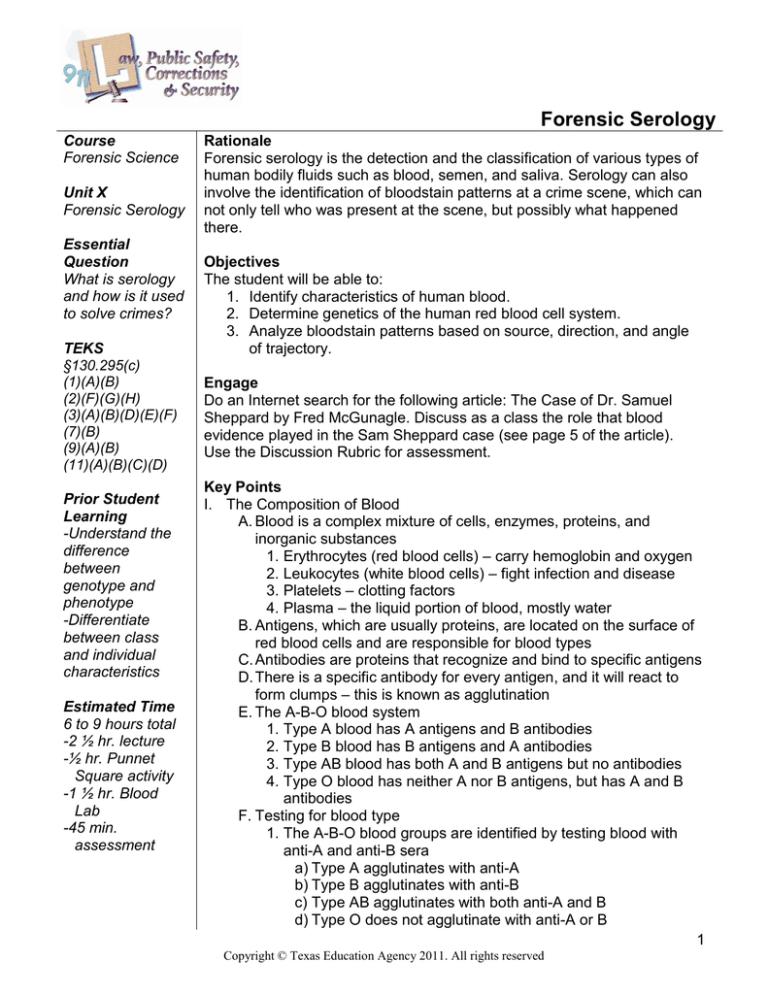
Forensic Serology Course Forensic Science Unit X Forensic Serology Essential Question What is serology and how is it used to solve crimes? TEKS §130.295(c) (1)(A)(B) (2)(F)(G)(H) (3)(A)(B)(D)(E)(F) (7)(B) (9)(A)(B) (11)(A)(B)(C)(D) Prior Student Learning -Understand the difference between genotype and phenotype -Differentiate between class and individual characteristics Estimated Time 6 to 9 hours total -2 ½ hr. lecture -½ hr. Punnet Square activity -1 ½ hr. Blood Lab -45 min. assessment Rationale Forensic serology is the detection and the classification of various types of human bodily fluids such as blood, semen, and saliva. Serology can also involve the identification of bloodstain patterns at a crime scene, which can not only tell who was present at the scene, but possibly what happened there. Objectives The student will be able to: 1. Identify characteristics of human blood. 2. Determine genetics of the human red blood cell system. 3. Analyze bloodstain patterns based on source, direction, and angle of trajectory. Engage Do an Internet search for the following article: The Case of Dr. Samuel Sheppard by Fred McGunagle. Discuss as a class the role that blood evidence played in the Sam Sheppard case (see page 5 of the article). Use the Discussion Rubric for assessment. Key Points I. The Composition of Blood A. Blood is a complex mixture of cells, enzymes, proteins, and inorganic substances 1. Erythrocytes (red blood cells) – carry hemoglobin and oxygen 2. Leukocytes (white blood cells) – fight infection and disease 3. Platelets – clotting factors 4. Plasma – the liquid portion of blood, mostly water B. Antigens, which are usually proteins, are located on the surface of red blood cells and are responsible for blood types C. Antibodies are proteins that recognize and bind to specific antigens D. There is a specific antibody for every antigen, and it will react to form clumps – this is known as agglutination E. The A-B-O blood system 1. Type A blood has A antigens and B antibodies 2. Type B blood has B antigens and A antibodies 3. Type AB blood has both A and B antigens but no antibodies 4. Type O blood has neither A nor B antigens, but has A and B antibodies F. Testing for blood type 1. The A-B-O blood groups are identified by testing blood with anti-A and anti-B sera a) Type A agglutinates with anti-A b) Type B agglutinates with anti-B c) Type AB agglutinates with both anti-A and B d) Type O does not agglutinate with anti-A or B 1 Copyright © Texas Education Agency 2011. All rights reserved G. Blood donors and recipients 1. Type A donates to Type A and Type AB, and receives from Type A and Type O 2. Type B donates to Type B and Type AB and receives from Type B and Type O 3. Type AB donates only to Type AB and receives from all Types (making it the universal recipient) 4. Type O donates to all types but receives only from Type O (making it the universal donor) H. The Rh (Rhesus) factor 1. Another important blood antigen 2. A protein that some people carry; sometimes referred to as the D antigen 3. People with the D antigen are said to be Rh positive (+) and those without are Rh negative (-) 4. Important for the compatibility of donors and recipients 5. An Rh+ person can receive Rh+ or Rh- blood, but an Rhperson can only receive Rh- blood 6. The blood is Rh+ if it agglutinates with anti-D or Rh- if it does not II. The Genetics of Blood A. To determine blood types, there are two inherited genes (one from each parent) B. There are three alleles for blood types: A, B, and O with six possible combinations 1. Type A= AA, AO 2. Type B= BB, BO 3. Type AB= AB 4. Type O= OO C. A Punnett square can be used to determine the blood types of offspring from specific parent combinations III. The Forensics of Blood A. Forensic investigators must answer three main questions 1. Is it blood? a) To answer, use a presumptive test which is a preliminary color test (1) Kastle-Meyer is used for visible blood stains and causes a deep pink color in the presence of hemoglobin (2) Luminol can be used for invisible stains where, in the presence of blood, it will produce a luminescence in a darkened area 2. Is it human or animal blood? a) The precipitin test identifies the presence of proteins that are found only in human blood (1) Human blood is injected into an animal (usually a 2 Copyright © Texas Education Agency 2011. All rights reserved rabbit) (2) Antibodies neutralize the invading human blood to form human antiserum (3) The bloodstain in question is layered on top of the antiserum in a capillary tube (4) If human blood is present, a ring or band is formed at the interface of the two liquids 3. Whose blood is it? a) A DNA analysis must be performed IV. Characterization of Blood Evidence A. Class characteristics of blood evidence 1. What species does it belong to? 2. What blood type is it? 3. What is the Rh factor? 4. Does the evidence have any diseases present? B. Individual characteristics of blood evidence from DNA analysis V. Bloodstain Pattern Analysis A. The appearance, distribution, and location of blood spatter can tell a lot about a crime scene 1. Surface texture can change the appearance of a blood drop 2. Categories of blood sources include a) Passive – dripping b) Transfer – from one item to another (1) Wipe – a non-bloody object comes in contact with a bloody surface (2) Swipe – a bloody object comes in contact with a nonbloody surface c) Projected – shootings, blunt force trauma, etc. 3. The direction of travel can be determined when blood strikes a surface because the pointed end of each drop faces its direction of travel 4. The angle of impact is determined by measuring the width and the length of the drop, dividing the width by the length, then finding the inverse sin a) The drop will be circular at right angles to the surface b) As the angle decreases, the drop elongates 5. The origin of spatter a) Draw straight lines through the long axis of several bloodstains b) The intersection, called the area of convergence, represents the origin point VI. Other body fluids associated with serology A. Characterization of Saliva 1. Saliva is a mixture of the following a) Water 3 Copyright © Texas Education Agency 2011. All rights reserved b) Mucin, which aids in swallowing c) Amylase, an enzyme used for digestion d) Buccal cells, also known as cheek cells that are a good source of DNA 2. It is particularly associated with sexual assaults and bite marks 3. To test for saliva a) Mix starch, iodine, and the sample of presumed saliva b) Starch turns dark blue or purple in the presence of iodine c) However, amylase breaks down starch so the color will fade B. Characterization of Semen 1. Semen is made of a) Water b) Spermatozoa c) Enzymes d) Inorganic salts 2. It is associated mostly with sexual assaults 3. To test for semen a) Presumptive test (1) Semen fluoresces under UV light (2) Turns purple in the presence of acid phosphatase b) Confirmatory test (1) Microscopic examination reveals spermatozoa (2) DNA typing must be done to individualize the sample C. Characterization of Urine 1. Enzyme-Multiplied Immunoassay Technique (EMIT) analysis for detecting drugs in urine a) Antibodies that will bind to specific drugs are added to a urine sample Activities 1. Blood Lab. This is a three-part lab. First, students will observe the agglutination process to identify blood types. Second, they will observe and identify visible and invisible bloodstains. Finally, they will calculate angles of impact. See the Forensic Blood Lab Teacher Notes for detailed instructions. Use the Forensic Blood Lab Worksheets for the activity. Note: This activity should be based on accuracy and details at the teacher’s discretion. No set rubric is provided, but the Individual Work Rubric maybe used as appropriate. 2. Punnett Square Blood Type Activity. Have the students complete the Understanding Human Blood Types Using Punnett Squares Worksheet. Use the Understanding Human Blood Types Using Punnett Squares Worksheet Key for assessment. Assessments 4 Copyright © Texas Education Agency 2011. All rights reserved Forensic Serology Exam and Key Blood Quiz and Key Discussion Rubric Individual Work Rubric Summary Rubric Materials Forensic Serology computer-based presentation Punnet Square Activity Handout Forensic Blood Lab Teacher Instructions Forensic Blood Lab Worksheets Blood Lab – Simulated blood – Anti-A, anti-B, and anti-D (Rh) serum – Cotton swabs – Distilled water – Blood type slides – Toothpicks – Kastle-Meyer solution – Stained cloth – Blood (such as that found in the bottom of a meat tray from ground beef or liver) – Luminol – Clipboard – Calculator – White paper – Ruler – Protractor Resources 0135158494, Saferstein, Richard. Forensic Science: An Introduction. New Jersey: Pearson Prentice Hall, 2011. 0536522820, Saferstein, Richard. Criminalistics: An Introduction to Forensic Science. 8th ed. Upper Saddle River, NJ; Pearson Prentice Hall, 2004. Do an Internet search for the following: The Case of Dr. Samuel Sheppard by Fred McGunagle Accommodations for Learning Differences For reinforcement, students will work as a group to create their own blood typing problem using Punnet squares, such as those found in the Punnet Square Activity. This problem will be presented to the class via an interactive white board, if available. The groups will complete each other’s problems. Use the Individual Work Rubric for assessment. For enrichment, students will search the internet and summarize a notorious crime that was solved utilizing bloodstain pattern analysis. Use the Summary Rubric for assessment. 5 Copyright © Texas Education Agency 2011. All rights reserved State Education Standards Texas Essential Knowledge and Skills for Career and Technical Education §130.295. Forensic Science (One Credit). (1) The student, for at least 40% of instructional time, conducts laboratory and field investigations using safe, environmentally appropriate, and ethical practices. These investigations must involve actively obtaining and analyzing data with physical equipment, but may also involve experimentation in a simulated environment as well as field observations that extend beyond the classroom. The student is expected to: (A) demonstrate safe practices during laboratory and field investigations; and (B) demonstrate an understanding of the use and conservation of resources and the proper disposal or recycling of materials. (2) The student uses scientific methods and equipment during laboratory and field investigations. The student is expected to: (F) collect and organize qualitative and quantitative data and make measurements with accuracy and precision using tools such as calculators, spreadsheet software, data-collecting probes, computers, standard laboratory glassware, microscopes, various prepared slides, stereoscopes, metric rulers, electronic balances, gel electrophoresis apparatuses, micropipettors, hand lenses, Celsius thermometers, hot plates, lab notebooks or journals, timing devices, cameras, Petri dishes, lab incubators, meter sticks, and models, diagrams, or samples of biological specimens or structures; (G) analyze, evaluate, make inferences, and predict trends from data; and (H) communicate valid conclusions supported by the data through methods such as lab reports, labeled drawings, graphic organizers, journals, summaries, oral reports, and technology-based reports. (3) The student uses critical thinking, scientific reasoning, and problem solving to make informed decisions within and outside the classroom. The student is expected to: (A) in all fields of science, analyze, evaluate, and critique scientific explanations by using empirical evidence, logical reasoning, and experimental and observational testing, including examining all sides of scientific evidence of those scientific explanations, so as to encourage critical thinking by the student; (D) evaluate the impact of scientific research on society 6 Copyright © Texas Education Agency 2011. All rights reserved and the environment; evaluate models according to their limitations in representing biological objects or events; and (F) research and describe the history of science and contributions of scientists. The student recognizes the methods to process and analyze trace evidence commonly found in a crime scene. The student is expected to: (B) process trace evidence such as soil, grass, glass, blood, fibers, and hair collected in a simulated crime scene; The student analyzes blood spatter at a simulated crime scene. The student is expected to: (A) analyze blood stain patterns based on source, direction, and angle of trajectory; and (B) explain the method of chemically isolating an invisible blood stain using reagents such as luminol. The student explores serology laboratory procedures in forensic science. The student is expected to: (A) explain forensic laboratory procedures to determine if a stain detected in a crime scene is blood; (B) identify the red blood cell antigens and antibodies as they relate to human blood types; (C) determine genotypes and phenotypes in the human red blood cell system using Punnet Squares; and (D) research methodologies used to collect and analyze other body fluids. (E) (7) (9) (11) College and Career Readiness Standards Science Standards I. Nature of Science: Scientific Ways of Learning and Thinking E. Effective communication of scientific information 1. Use several modes of expression to describe or characterize natural patterns and phenomena. These modes of expression include narrative, numerical, graphical, pictorial, symbolic, and kinesthetic. 2. Use essential vocabulary of the discipline being studied. 7 Copyright © Texas Education Agency 2011. All rights reserved Name:___________________________________ Date:________________________ Forensic Serology Exam The following is a scenario of a fictional crime scene. Use your knowledge of blood and DNA to answer, making sure to include terminology and steps when necessary. Scenario: An unknown homicide victim has been found rolled up in a blood-soaked sheet. On the victim, a bite mark is found on the hand. Describe the proper steps necessary to preserve the evidence of this crime scene. List all terms and requirements needed to complete a thorough examination of the blood and DNA evidence. 8 Copyright © Texas Education Agency 2011. All rights reserved Forensic Serology Exam Key Note: This assessment should be based on accuracy and details at the teacher’s discretion. No set rubric is provided. The student’s answer should include, but not necessarily be limited to Drops on the sidewalk – Must first do a presumptive test, such as Kastle-Meyer, to determine if it is blood – Indicates passive blood stain; dripping – Could possibly indicate direction of movement if a pattern is evident – Check blood type to see if it is the same type as the victim or sheet – Swab a drop with a sterile swab moistened with sterile distilled water to be later used for DNA testing Sheet – Must first do a presumptive test, such as Kastle-Meyer, to determine if it is blood; swab one small area the same way as described above – Lay it completely out to see if there are any blood stain patterns evident – Check the blood type to see if it is the same type as the victim or sidewalk drops – Make sure the sheet is completely dry before placing it in a paper bag for evidence Victim – Observe to see if wounds are present, and if so, whether or not they were made by a particular weapon – If wounds are present, check to see is they are consistent with having made the stains on the sheet or the drops on sidewalk – Search the nearby area for any possible weapons or other bloodstain patterns 9 Copyright © Texas Education Agency 2011. All rights reserved Name:___________________________________ Date:________________________ Blood Quiz Multiple Choice 1) _____ An individual who is Type O blood has a) O antibodies b) B antibodies c) Both A and B antibodies d) Neither A nor B antibodies 2) _____ To distinguish between human and animal blood, a _____ test is used. a) Color b) Precipitin c) Serology d) Presumptive 3) _____ If blood is found to have both A and B antigens it is considered type a) A b) B c) AB d) O 4) _____ When studying angles of impact, which of the following angles would be most accurate to describe a circular blood drop? a) 10 degrees b) 40 degrees c) 70 degrees d) 90 degrees 5) _____ One parent is type AB and the other parent is type O. A possible genotype for an offspring is a) AB b) OO c) AO d) All of the above True or False (T or F) 6) _____ The first thing an investigator must determine when finding a bloodstain is whether it is human or animal blood. 7) _____ A person with Rh- blood can receive either Rh+ or Rh- blood. 8) _____ Luminol can be used to detect invisible bloodstains. 9) _____ A swipe is when a non-bloody object comes in contact with a bloody surface. 10) _____ Kastle-Meyer is a presumptive test for blood that turns bright pink in the presence of hemoglobin. 10 Copyright © Texas Education Agency 2011. All rights reserved Blood Quiz Key 1) C 2) B 3) C 4) D 5) C 6) False 7) False 8) True 9) False 10) True 11 Copyright © Texas Education Agency 2011. All rights reserved Forensic Blood Lab Teacher Notes Rationale: This lab activity allows students to identify characteristics of blood. Students will 1) Identify blood types based on the agglutination process (Part 1) 2) Observe visible and invisible bloodstains using different chemicals (Part 2) 3) Analyze bloodstain patterns based on angles of trajectory (Part 3) Materials: Part 1 (This part can be purchased as a “Blood-type Kit” from any biological supply company; they are inexpensive and refills are available) – Synthetic blood samples (may be purchased from any biological supply company) – Testing plates or glass slides – Anti-A sera, Anti-B sera, and Anti-D sera – Toothpicks Part 2 (For this part, animal blood, such as that from a liver, can be used to create the stains) – A piece of cloth with 2 stains on it (one should be from actual blood and the other from another red liquid). Mark the stains A and B – A nonporous area (such as the floor) where blood has been smeared then wiped up – Kastle-Meyer solution (phenolphthalein/peroxide solution) – Cotton swabs – Distilled water – A spray bottle with luminol* * The test for invisible bloodstains using luminol can be done in the classroom as a demo, where the teacher completely darkens the room and sprays the area with luminol as the students observe. Make sure that the room is well ventilated beforehand. Part 3 - Simulated blood (or other red liquid to represent blood) A plastic dropper Protractor Ruler Directions: Refer to the student Forensic Blood Lab Worksheet for the specific lab procedure. Answers may vary 12 Copyright © Texas Education Agency 2011. All rights reserved Name:______________________________ Date:_____________________ Forensic Blood Lab Worksheets PART 1 – BLOOD TYPES Purpose: Identify specific blood types by visualizing agglutination. Materials: – Simulated blood samples 1-4 – Blood typing slide (with A, B, and Rh wells) – Synthetic anti-A sera – Synthetic anti-B sera – Synthetic anti-D (Rh) sera – Toothpicks Procedure: 1. Add a drop of simulated blood sample 1 to each well of the blood typing slide. 2. Add a drop of anti-A serum to the well labeled “A.” 3. Add a drop of anti-B serum to the well labeled “B.” 4. Add a drop of anti-D (Rh) serum to the well labeled “Rh.” 5. Using a different toothpick for each well, stir for about 30 seconds. 6. Carefully examine the mixture in each well. If the liquid is uniform in appearance, there is no agglutination, so the sample is negative for that type. If the liquid appears granular, agglutination has occurred, and it is positive for that type. Record your results in the data table below. 7. Thoroughly wash each well and repeat the steps for the remaining blood types. BLOOD TYPE DATA TABLE Sample 1 Sample 2 Sample 3 Sample 4 Anti-A Anti-B Anti-D (Rh) BLOOD TYPE Illustrate your observation of the blood typing slide of one of the 4 samples. Sample ______________________ Blood Type ___________________ 13 Copyright © Texas Education Agency 2011. All rights reserved PART 2 – PRESUMPTIVE TEST Purpose: Verify that bloodstains are truly blood by chemical test and visualization. Materials: - Cloth with possible bloodstains 1 and 2 - Cotton swabs - A dropper bottle with distilled water - A dropper bottle with Kastle-Meyer solution - A spray bottle with luminol Procedure: Visible Stains 1. Observe the cloth with stains 1 and 2 2. Moisten the end of a swab with one drop of distilled water 3. Rub it onto one of the stains 4. Put one drop of the Kastle-Meyer solution onto the swab and observe 5. Using another swab, repeat the steps for the other stain and record your observations in the data table Stain PRESUMPTIVE BLOOD TEST FOR VISIBLE STAINS Color Positive Test for Blood? 1 2 Invisible Stains 1. Observe the area designated by teacher. Do you see evidence of blood? Explain: _________________________________________________________________________ _________________________________________________________________________ _________________________________________________________________________ 2. What happened after the area was sprayed with luminol? _________________________________________________________________________ _________________________________________________________________________ 14 Copyright © Texas Education Agency 2011. All rights reserved PART 3 – ANGLES OF IMPACT Purpose: Analyze bloodstain patterns based on angles of trajectory Materials: – Simulated blood in a dropper bottle – Ruler – Calculator – Protractor – Blank White Paper – A clipboard Procedure: 1. Secure the sheet of paper onto the clipboard. 2. Drop a single drop of simulated blood onto the paper from approximately 12” above the clipboard that is flat on a lab table. Label this drop 90 degrees. 3. Holding the protractor flat on the table, position the clipboard so it is at a 60 degree angle. Place a drop on the paper and label the drop. 4. Repeat Step 3 for 30 degrees and 15 degrees, keeping the height the same each time. 5. Allow the stains to dry. 6. Measure the width and the length of each stain. Record this in the data table. 7. To calculate the angle of impact, use the following: Sin of angle = width of stain length of stain *The sin of the angle can be converted to the angle by hitting the arcsin button (sin-1) 8. Record your data below. CALCULATED ANGLES OF IMPACT Angle Width Length W/L Calculated Angle 90 60 30 15 15 Copyright © Texas Education Agency 2011. All rights reserved POST-LAB QUESTIONS 1. Was it easy to distinguish drops that agglutinated from those that didn’t? Explain. ______________________________________________________________________________ ______________________________________________________________________________ ______________________________________________________________________________ ______________________________________________________________________________ 2. When observing the stained cloth, could you distinguish bloodstain from other stains before testing? How? ______________________________________________________________________________ ______________________________________________________________________________ ______________________________________________________________________________ ______________________________________________________________________________ After testing? What did you see? ______________________________________________________________________________ ______________________________________________________________________________ ______________________________________________________________________________ ______________________________________________________________________________ 3. Does the Kastle-Meyer test prove that the blood is human? Explain your answer. ______________________________________________________________________________ ______________________________________________________________________________ ______________________________________________________________________________ ______________________________________________________________________________ 4. Did your calculated angles match the angles they were supposed to represent? What could cause discrepancies? ______________________________________________________________________________ ______________________________________________________________________________ ______________________________________________________________________________ ______________________________________________________________________________ 16 Copyright © Texas Education Agency 2011. All rights reserved Name__________________________________Date___________________________ Understanding Human Blood Types Using Punnett Squares Worksheet DIRECTIONS: 1) In the table below, fill in the appropriate genotypes for each blood type. Then complete the following Punnett square problems: PHENOTYPE GENOTYPE (S) A B AB O 2) A man who has the type B blood (genotype: BB) is married to a woman with type O blood. What blood type will their children have? 3) A woman with type A blood is claiming that a man with type AB blood is the father of her child, who is also type AB. Could this man be the father? Show the possible crosses. 4) A man with type AB blood is married to a woman with type O blood. They have two natural children, and one adopted child. The children's blood types are: A, B, and O. Which child was adopted? 17 Copyright © Texas Education Agency 2011. All rights reserved Understanding Human Blood Types Using Punnett Squares Worksheet Key 1) Type A=AA, AO; Type B=BB, BO; Type AB=AB; Type O=OO 2) BB X OO = BO All children have Type B 3) AA X AB = AA or AB; or AO X AB = AA, AB, AO, or BO; therefore, yes he could be the father. 4) AB X OO = AO or BO; The Type O child is adopted. 18 Copyright © Texas Education Agency 2011. All rights reserved Name_______________________________________ Date_______________________________ Discussion Rubric Objectives 4 pts. Excellent 3 pts. Good 2 pts. Needs Some Improvement 1 pt. Needs Much Improvement N/A Pts. Participates in group discussion Encourages others to join the conversation Keeps the discussion progressing to achieve goals Shares thoughts actively while offering helpful recommendations to others Gives credit to others for their ideas Respects the opinions of others Involves others by asking questions or requesting input Expresses thoughts and ideas clearly and effectively Total Points (32 pts.) Comments: 19 Copyright © Texas Education Agency, 2011. All rights reserved. Name______________________________________ Date_______________________________________ Individual Work Rubric 4 pts. Excellent Objectives 3 pts. Good 2 pts. Needs Some Improvement 1 pt. Needs Much Improvement N/A Pts. Follows directions Student completed the work as directed, following the directions given, in order and to the level of quality indicated Time management Student used time wisely and remained on task 100% of the time Organization Student kept notes and materials in a neat, legible, and organized manner. Information was readily retrieved Evidence of learning Student documented information in his or her own words and can accurately answer questions related to the information retrieved *Research/Gathering information (if relevant) Student used a variety of methods and sources to gather information. Student took notes while gathering information Total Points (20 pts.) Comments: 20 Copyright © Texas Education Agency, 2011. All rights reserved. Name_______________________________________ Date_______________________________ Summary Rubric Objectives 4 pts. Excellent 3 pts. Good 2 pts. Needs Some Improvement 1 pt. Needs Much Improvement N/A Pts. The critical analysis has all required parts from introduction to body to conclusion. The critical analysis is concise but complete. The critical analysis demonstrates that the writer comprehends the content. The critical analysis demonstrates accurate spelling, grammar, and punctuation. The overall content of the critical analysis emphasizes appropriate points. The writer shows an understanding of sentence structure, paragraphing, and punctuation. The source of the critical analysis is clearly and accurately documented. The critical analysis demonstrates the correct use of terminology. Total Points (32 pts.) Comments: 21 Copyright © Texas Education Agency, 2011. All rights reserved.
